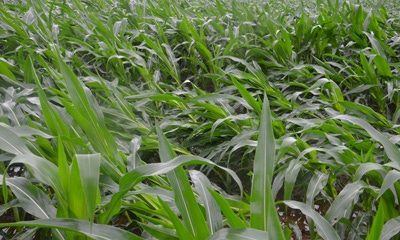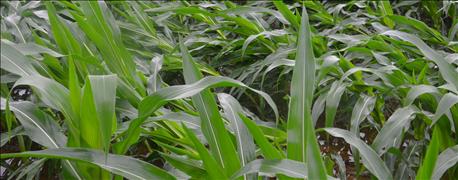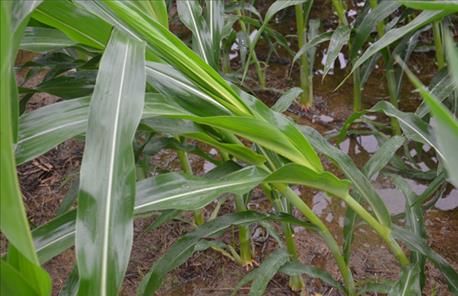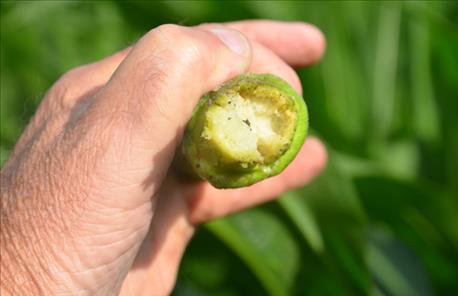
The sky gets dark and the wind picks up. You check radar on your cellphone app and see a red band headed squarely toward your farm. Moments later, the wind roars and the clouds open up, spilling out a large amount of rain. There is no hail — just a strong, straight-line wind and lots of driving rain. If you get in your truck after the storm and drive around your farm, what will you see? Will the corn be standing?
That can depend upon a lot of factors, notes Dave Nanda, crops consultant with Seed Consultants Inc., sponsor of Crop Watch ’16.

MORE VULNERABLE: The younger the corn, typically the more vulnerable it is to wind damage. This field in Scott County shows effects of wind just after a summer storm.
So far the Crop Watch field has escaped big storms. However, other fields in the eastern Corn Belt haven’t been as lucky. Spotty reports of minor damage, largely from wind, have come in all summer.
One factor is when the damage occurs. One source says corn is more vulnerable to blowing over in a strong windstorm earlier in the season, before tasseling. That’s because there is less lignin content in the stalks, and they don’t tend to be as strong as they are during pollination.
Plants that emerged later or that are smaller may be more vulnerable. Wind can quickly sort out which plants don’t have the ability to stand well.
How well plants withstand wind can be partly tied to genetics. Some hybrids have stronger stalks than others. In many cases, though, it’s more a function of how strong winds are, what direction they come from, and whether the ground is saturated already when the winds arrive. The more saturated the soil, the higher the possibility that roots are not anchored well in the soil, or that they might be more subject to giving way.
Impact of wind

WEAKER PLANTS LEAN FIRST: A windstorm quickly points out which plants are younger and weaker in the cornfield.
Typically, if plants are left leaning after a storm, they will straighten back up. Some plants may snap off. Often that's called "green snap," Nanda says. Obviously, if plants snap off with the growing point aboveground, which is typically the case, those plants are done.
Corn is often more vulnerable again later in the season, just before harvest, Nanda says. That may be especially true if stalk rot disease organisms have invaded a significant number of plants. Plants infected with stalk rot tend to be weaker and more subject to lodging. The ears may already be finished developing, so the concern and possible yield loss then stems from whether you can get ears into the combine.
Several years ago an intense storm roared through northern Tippecanoe County in late September. Corn was drying down and nearly ready for harvest. The winds were so ferocious that whole areas of the field were laid flat, with only a few stalks standing here and there. Most of the stalks bent 6 to 12 inches above the ground and fell over. Only a few snapped off.

GREEN SNAP: When the storm is severe, some plants snap, particularly earlier in the season.
A new-style, low-profile corn head for the time helped pull the vast majority of ears into the combine. Yield losses were minimal, although the farmer had to run very slow, and occasionally harvested in only one direction.
The bottom line is that until corn is in the hopper, wind damage can be a threat.
About the Author(s)
You May Also Like




